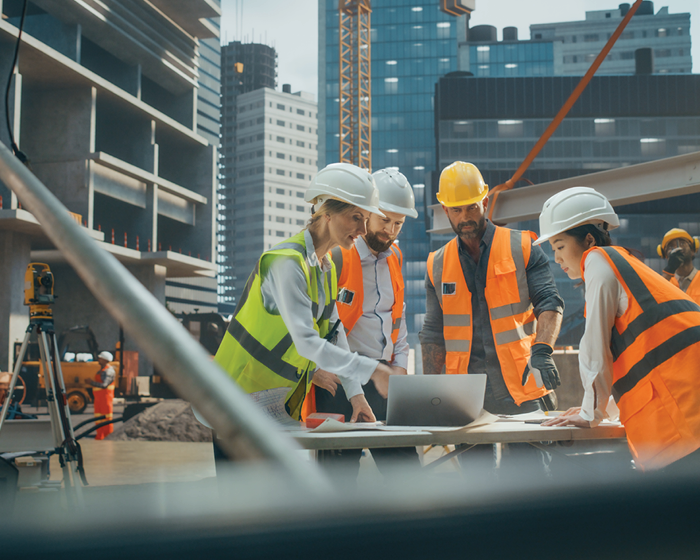Key Takeaways
- Emerging sustainability and ESG compliance standards are putting increased pressure on construction and real estate businesses.
- Improving sustainability can help businesses reduce risk and build brand trust and loyalty.
- An advisor with a deep understanding of both sustainable practices and industry standards can help you meet sustainability goals at the business and project level.
The global construction and real estate industry is responsible for around 40% of global emissions and uses more than half of all raw materials and natural resources. Sustainable construction practices are key to reducing these impacts — and a way for construction and real estate companies to build a competitive advantage.
With regulators and customers alike expecting more energy-efficient, sustainable buildings, being more sustainable can help businesses reduce risk and build trust.
Sustainable construction isn't just about compliance; it's about seizing a critical competitive advantage and safeguarding your business for the future.
The Changing Regulatory Landscape
To remain compliant, mid- to large-sized construction and real estate businesses must be aware of emerging regulations at both the state and federal level.
For example, construction companies that conduct business in California should prepare for California’s Climate Rule (SB 219):
- If a construction or real estate company makes over $500 million, it should be prepared to report its climate risks in 2026 and every second year after that.
- Companies making more than $1 billion in revenue will have to report climate risk plus Scope 1 and 2 in 2026 and Scope 3 the year after that.
While not finalized, states including New York, Washington, Illinois, and New Jersey have similar rules. Construction and real estate companies with over $500 million or $1 billion in revenue that do business in those states should start preparing for compliance.
Small businesses should consider some additional rules. For example, if your company builds properties for the California state government, an upcoming rule, SB 755, will require contractors:
- With over $5 million in contracts to report their Scope 1 and 2 emissions from 2027 onwards.
- With over $25 million to report their Scope 1, 2, and 3 emissions and climate risks from 2027 onwards.
Plus, each real estate project has sustainable building spec requirements that every construction and real estate company must meet. For example:
- Waste management: States, cities, and municipalities have certain rules on how much construction waste must be recycled. Austin, TX, requires covered building projects (any building above 5,000 square feet) to reuse or recycle at least 50% of building material waste.
- Energy efficiency: Most states also have some sort of energy efficiency regulation. The Energy Conservation Construction Code of New York State set minimum insulation, energy-efficient heating, lighting, and water standards that builders must abide by.
- Existing building performance standards: Real estate agents with existing stock must also consider new state regulations. In Washington, D.C., the Building Energy Performance Standards require some buildings to meet energy efficiency benchmarks by 2032.
Compliance planning is crucial for real estate developers and builders of every size and in every jurisdiction.
Sustainability as Competitive Advantage
While compliance is essential, it's not the only reason construction companies should embrace sustainability in 2025. Here are three ways companies can build a competitive advantage through sustainable construction:
- Differentiation: Stand out from the competition by offering buyers more energy-efficient properties that score high on green building certifications.
- Cost savings: Smarter design and procurement practices can reduce resource use.
- Brand reputation: Companies that offer more sustainable buildings and brand themselves as green builders can build strong reputations, attract new clients, and sell at a premium.
Actionable Steps to Prepare for 2025
To stay ahead of compliance deadlines and build a competitive advantage in 2025, consider these steps:
Conduct a Materiality and Climate Risk Assessment
A materiality assessment will determine your real estate or construction company’s most material sustainability-related risks and help you understand where you should focus, the regulations you currently face, what data to collect and report, where opportunities may lie, and where to prioritize action.
Establish Internal Sustainability Goals
Set goals and KPIs for the percentage of waste recycled or reused and the amount of emissions reduced or avoided. Utilize these goals to train staff on best practices to reduce operational environmental footprint.
Measure, Report, and Reduce Emissions Data
Regulators and stakeholders are paying close attention to emissions. The table below is an overview of the sources of emissions for construction and real estate, as well as the most common sources of these emissions in the two sectors.
| GHG Emissions Scope | Real Estate | Construction |
|---|---|---|
|
Scope 1 Direct emissions from owned or controlled sources |
Sources:
|
Sources:
|
|
Contribution: 2% of total emissions |
Contribution: 7% of total emissions |
|
|
Scope 2 Indirect emissions from the generation of purchased energy |
Sources:
|
Sources:
|
|
Contribution: 4% of total emissions |
Contribution: 1% of total emissions |
|
|
Scope 3 All other indirect emissions that occur in the value chain |
Sources:
|
Sources:
|
|
Contribution: 94% of total emissions |
Contribution: 92% of total emissions |
Most organizations focus on reducing Scope 1 and 2 emissions first and build up to Scope 3 over time. Some simple strategies to start reducing emissions from these sources include:
- Scope 1: Purchase more energy-efficient on-site machinery and use electric or hybrid vehicles where possible.
- Scope 2: Implement energy efficiencies (insulation, LED lighting, etc.), purchase from renewable energy providers, and engage with employees and tenants to change behavior.
- Scope 3: Work with suppliers, improve procurement practices, optimize supply chains, and offer energy-efficient appliances to future tenants.
Pursue Industry Certifications
One of the most practical ways real estate businesses can show that they are building sustainably is through accreditations, like Leadership in Energy and Environmental Design (LEED).
Research has shown that LEED-certified buildings can sell for 20% more per square foot compared to non-LEED-certified buildings.
LEED determines how sustainable a building is based on a rating system for the building construction and design, out of a score of 100. Buildings that perform well can be certified at four levels:
- Certified (40-49 points)
- Silver (50-59 points)
- Gold (60-79 points)
- Platinum (80+ points)
Construction and real estate companies can then use these scores to market their buildings, making them easier to sell for higher prices.
Work with Construction and Real Estate Advisors
Sustainability is vital for every construction and real estate company, and every building project. Businesses are being asked to report on their company-wide sustainability and set commitments and targets. On the project level, each building must keep in line with evolving sustainability regulations.
Working with an advisor with a deep understanding of both sustainable practices and industry standards will ensure your business stays compliant and can build a competitive advantage.
At Eide Bailly, we offer sector-specific expertise to help construction and real estate companies meet sustainability goals at the business and project level. From climate risk assessments to LEED certification support, our advisors bring practical, tailored solutions to future-proof your business.
Make a habit of sustained success.

Construction & Real Estate
Sustainability & EGS
Who We Are
Eide Bailly is a CPA firm bringing practical expertise in tax, audit, and advisory to help you perform, protect, and prosper with confidence.



